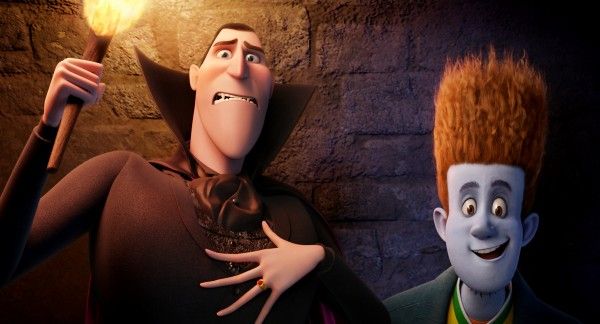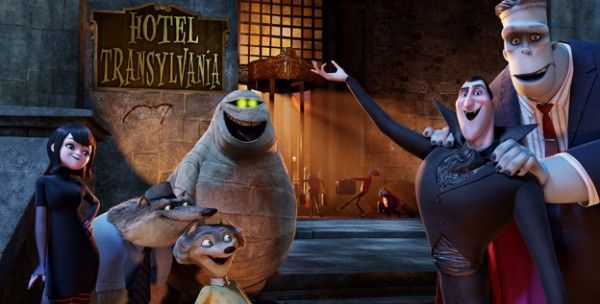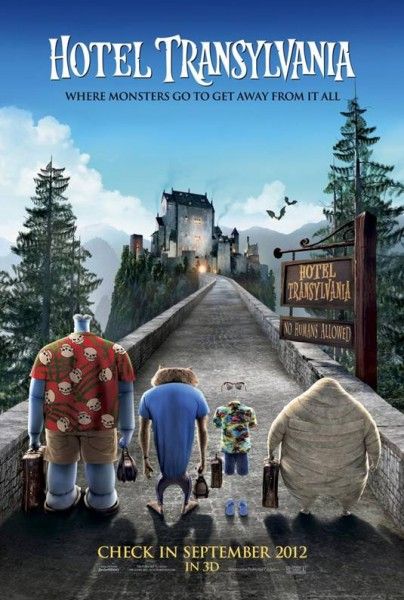This week, Collider was invited to participate in an early footage preview for the Sony Pictures Animation film Hotel Transylvania, opening in theaters on September 28th. Set in Dracula’s (Adam Sandler) lavish resort where monsters and their families can be free to be who they are without humans to bother them, the story follows his beloved daughter Mavis (Selena Gomez), who longs to explore the world on her 118th birthday. But, things are drastically shaken up when a human guy (Andy Samberg) stumbles into the hotel and takes an immediate shine to Mavis.
After getting to see a series of scenes from the film, which looks to be both funny and heartfelt, and showcased some of the wacky and wild legendary monsters featured in it, we got the opportunity to speak with director Genndy Tartakovsky (Samurai Jack, Dexter’s Laboratory) for this exclusive interview about the biggest challenges in making a family film about horror movie monsters, how much thought was put into bringing the film’s heroine to life, how much freedom he had for this interpretation of Dracula, working with Adam Sandler (who’s also the executive producer), what this experience taught him that he’ll be able to use for future projects, and dealing with the 3D aspect of it all. He also talked about his desire to stay in feature films, what it would take for a Samurai Jack movie to get made, and what he loves about animated storytelling. Check out what he had to say after the jump.
Collider: What were the biggest challenges in taking all of these horror movie monsters and making a family film with them?
GENNDY TARTAKOVSKY: You have to make the conscious decision not to go to scary-funny. You want to go there right away, but you have to decide, “Okay, we’re not doing that.” The next thing you want to avoid are puns. With a hotel for monsters, you can do a ton of humor like, “Oh, this movie is out of the grave,” and all that kind of stuff. That’s good for a laugh, but we really wanted to do a character comedy. For me, doing all the TV stuff and having the experience directing, knowing what you want to make is 90% of it. The rest of it is just guiding everybody on that one path. But, figuring out the path is the difficult part. If I could really close my eyes and watch the whole movie, then directing is easy. But, knowing what that movie is, is the hard part.
Once you had all these actors in place for all of the characters, were there any you were most surprised about seeing brought to life?
TARTAKOVSKY: The most satisfying one is, for sure, Dracula. To really have Dracula feel the way he feels, he feels like a star. But then, the most surprising was probably Quasimodo. At first, I didn’t have a good role for him. We went through a few things, but we just weren’t sure who he was. And then, once Jon Lovitz did these really funny reads and the animators were able to push Quasimodo to this really freaky looking guy, then he really came together and he became really funny. He became a really fun part of the movie.
Did you have to think a lot about how you would bring Mavis to life, considering that so many young girls would see her as a heroine?
TARTAKOVSKY: Yeah. It’s always difficult to do girls. The thing about any character is that you want to be sincere. It’s not like you go, “Okay, I’m going to get myself in a girl mode.” It wasn’t really about that. It was just about, “How can we make a sincere teenager and not do the standard thing?” It was staying away from that and designing it around Selena, in a way, to make her step into the role in a really easy way. She was young enough that she didn’t have a character that she’s so iconic with [that that’s all you saw]. Mavis could still retain her own identity. That was really challenging. Plus, you’ve got all these comedians doing jokes, and how does she fit in? Is she the straight person? How does that all work? It was a bit of a juggling act to get it all done. Another surprise came when, as soon as we put Jonathan and Mavis in a scene, all of a sudden, the movie became this romantic movie. But, we still wanted it to be about Dracula’s daughter, so I had to really juggle that. Those two things were much more difficult than I had anticipated.
When it came to Dracula, were there things that you knew you wanted to keep with the character, or did it feel like it was totally open to however you wanted to envision it?
TARTAKOVSKY: I think it was really open. I really wanted to think about when I think Adam is at his funniest and how I can structure the story to have moments where we can utilize that. For me, Adam has the big loud moments, and then the quiet little mumbley ones, and Dracula is just like that. When he’s controlling the hotel, he’s very controlled, and then with his daughter, he’s out of control. That made it all come together really easily because the character could drive it.
When you cast somebody like Adam Sandler, who’s so well known, but he’s doing an accent that makes him sound different, how do you decide how far to push that?
TARTAKOVSKY: I didn’t worry so much that people would know it’s him. I thought the publicity machine would probably take care of that. When I first met Adam, I asked him if he was going to do an accent because I didn’t know what he was thinking. Dealing with celebrities, I haven’t done it that much in my life, so I wasn’t sure. So, he was like, “Oh, I don’t know. I’ve been practicing in the shower and I’ve just been doing Zohan, so I don’t know what will happen.” And then, when he first came in and we did some test stuff, he started playing with a Transylvanian dialogue, and he found a nice place where he felt comfortable doing it. It really was great watching him work. Sometimes I can’t hear myself, but you could tell that he hears himself, and then he adjusts it. That was really fantastic to watch.
In doing a movie like this, where you’re thrown in the deep end with all these characters and you’re working with all these talented people, what did it teach you about this that will make it for you, the next time?
TARTAKOVSKY: Being thrown in the deep end is really interesting because it’s very accurate. For me, luckily I was able to run my own shows for awhile. It’s about having people believe in you. I came in with a whole lot of confidence and no question marks. People realized, “Oh, he wants this and this and that,” knowing that maybe some of those are mistakes, but they have to stand by them. It’s like a general in a battlefield. If you don’t believe your general, you’re not going to go into battle knowing you’re going to die. They had to have this confidence in me, and that’s what I learned. Trying to be a leader, you’ve got to be really sure of what you’re doing and you’ve got to guide people the right way. So, I was very bully-ish about what I wanted to do. Especially as a new person coming in, I would have been eaten alive, if I showed any kind of weakness. So, I really stood to my guns. Not that I didn’t make mistakes, but I really believed in what I was doing and I pushed it through.
Was it daunting to also deal with the 3D aspect of this?
TARTAKOVSKY: Yeah, a little bit. It’s hard enough just to make it work in one medium, much less two at the same time. But, once we positioned it, the kind of storytelling we were doing and the way I decided to shoot the movie actually made it really compatible with 3D. The two actually blended together nicely. It wasn’t as much of a chore as I thought it might be.
Do you have a very clear idea of where you want to go next? Do you want to stay in features?
TARTAKOVSKY: Yeah, watching a movie with an audience is so exciting. For me, coming from TV, you finish an episode and then it airs, and I’m at home. There’s no gratification and there’s no audience interaction with it. The internet makes it a little better now, but that’s so specific. When we did the first test screenings, and to watch it with an audience and actually sit in the movie theater and feel what the audience is feeling, that was incredible. It was like I was literally standing on stage, doing stand-up. But, I would be terrible at that and wouldn’t want to do that, which is why I’m behind the scenes. It’s just like that. It’s that same exhilarating feeling. I definitely want to keep pushing it and keep my hand on features for awhile.
Will there ever be a Samurai Jack animated feature or live-action movie?
TARTAKOVSKY: It’s still around. Every year, somebody new picks it up who tries to push it through. I feel like, with Jack, it’s a funny curse. People like it for A, B and C, but as soon as they want to make it, they say, “Well, we can’t do A, B and C.” But, those are the key ingredients that make it successful. Once somebody comes along and just says, “I want to make it for what it is,” then it will get made. But right now, every time we try to run it up the flagpole, it never sticks.
Is there something that you love most about animated storytelling that hasn’t drawn you to live-action?
TARTAKOVSKY: For me, animation is the caricature of life. It’s something that we create, from the ground up. So, everything that I’ve ever done is not really based on reality, it’s this caricature of reality, which is what’s really exciting. Even though we’re doing CG, there’s nothing as exhilarating as when I was sitting in an audience, at 12 or 14, watching The Jungle Book and seeing those drawings. I felt like I was the only one in the audience, at the time. Something about it just struck me. It was like a lightning bolt and I couldn’t get rid of it. I’m a true fan of animation, and it’s my livelihood. Live-action is secondary to me, right now.



